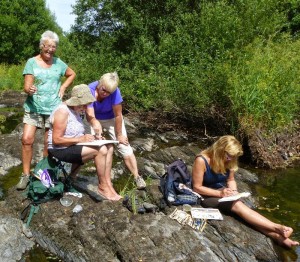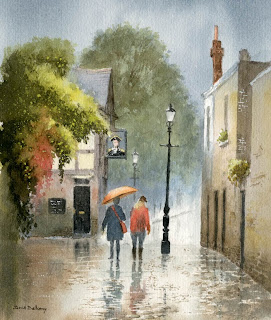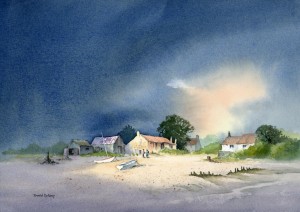With such a lot of intense heat of late in Britain it’s been excellent for painting out of doors. Getting out early in the morning or in the evening light is more preferable for those of you who find it just a little bit too hot, and finding some shade in the heat of the day is advisable, for the watercolour if not for the artist! Bright sunlight on white paper can really hurt your eyes, dry your washes too quickly, and give you a false sense of tonal values, so that when you return indoors your painting may look a little stark and contrasty. Take along and umbrella or other form of shade if you intend sitting in the sunshine to paint, and make sure it keeps your painting in shadow.

A few weeks ago I was asked how to depict intense heat in a painting. In this watercolour sketch I left much of the tops of the rocks as white paper, with much stronger tones on the sides forming a strong contrast. There was much more detail present, but adding too much detail can destroy the suggestion of sunlight, so keep it to a minimum in the lit areas. Cast shadows highlight the sunny effect, but here the sun is almost directly overhead, so there is not any great length to the shadows. The sense of intense heat has been further enhanced by laying a weak wash of blue-grey over the background.
 The sun beat down every day on our recent landscape course at Builth Wells, although happily we did have some welcome fluffy white clouds at times for variation. The ideal spot was down by the river running through the hotel grounds, where several students took the opportunity to dangle their feet in the water while they sketched. In the photo Jenny is giving advice as they paint a mixture of delightful cascades and still water punctuated with stunning colour reflections. Make the most of this lovely sketching weather.
The sun beat down every day on our recent landscape course at Builth Wells, although happily we did have some welcome fluffy white clouds at times for variation. The ideal spot was down by the river running through the hotel grounds, where several students took the opportunity to dangle their feet in the water while they sketched. In the photo Jenny is giving advice as they paint a mixture of delightful cascades and still water punctuated with stunning colour reflections. Make the most of this lovely sketching weather.



